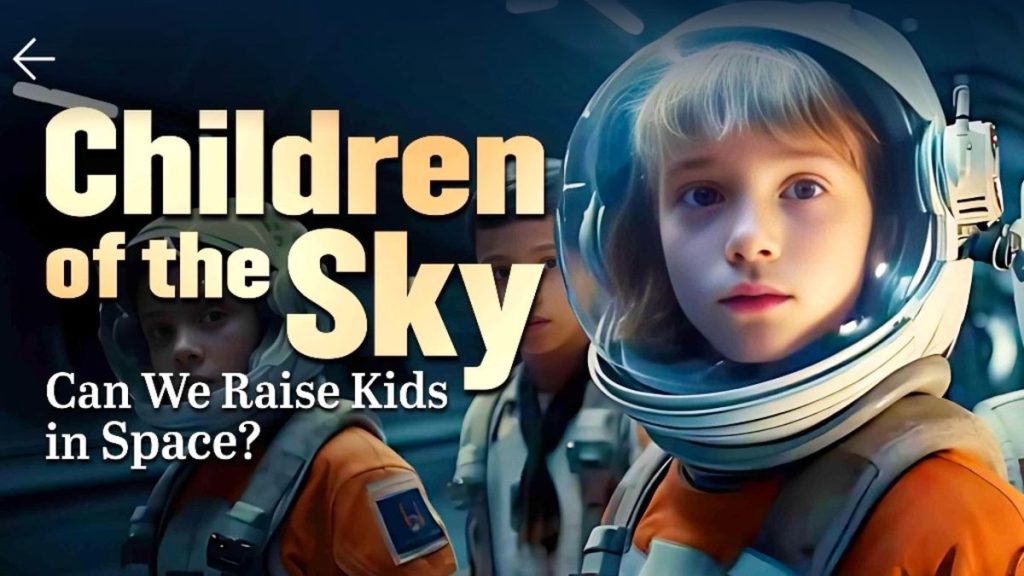But what defines a true community — as different from a simple base or an outpost — is that a proper settlement must maintain a self-sustaining population. And that means kids in space. Providing the nurturing care they’ll need will not be easy.
Right now, 100% of the human species calls Earth home. But very soon, on the timescale of human civilization, that may change. The first child born in space could mark the beginning of the humanization of the rest of the universe . Will it be safe to conceive, carry and raise children off-planet? What rights (and responsibilities) should parents and kids have in space and how can these entitlements (and obligations) be recognized and protected? Should a state, a company, or a parent be allowed to genetically modify a baby for survival off-Earth? Or implant an augmentation or device in a teenager “for their own well-being”?
I thought exploring these questions would make a compelling documentary film; one with no shortage of ethical and physical issues to consider:
What will be the impacts to kids growing up in microgravity or partial gravity? The radiation effects? Their citizenship and immigration status? Their parents’ de-facto indentured servitude far from Earth? What about eventual speciation, where we, Homo sapiens (“wise man”), become Homo spacialis (“space man”)? Or perhaps various flavors of cyborg?
Our film features six experts, each a specialist with pithy perspectives on biomedical, legal, moral, environmental and other questions around kids’ safety and well-being beyond Earth. My job as a filmmaker is not so much to answer such questions as to provide frameworks for you, the viewer, to explore your own feelings and expand your understanding.
I will freely admit, however, to having a bias: I’m a pro-growth dynamist and you’ll hear that in the film’s narrative. Though I feel deeply “for the Green,” I’m persuaded that, in the long-term, space development will help protect the gem that is Earth by unburdening our planet of atmospheric carbon, ecological trauma, biodiversity loss and, eventually, over-population (though we’re a very long way from that). That implies the humanization of the solar system, which takes our focus back to the health and well-being of children. But how to show you kids living possible futures beyond Earth?
Why AI images? And did I make a deal with the devil?
It is said that “societies have the morals they can afford” (sometimes attributed to 19th-century German philosopher Friedrich Nietzsche). To bring these issues to your screen, on a restrictive budget, I had to wrestle with the very significant ethical dilemmas and practical problems inherent in using Artificial Intelligence to generate illustrative images and animations. In the film, I use AI to help create conceptual images and animations about possible upcoming events in space. I do not use AI to falsely portray real people, nor do I recreate or dramatize historical events. I chose an “artist’s rendering” visual style, so there would be no confusion about the speculative nature of the images.
The core problem with generative visual Artificial Intelligence: It’s actually not yet very smart. It’s especially poor at generating technically precise imagery. It has issues depicting body parts. And it does not understand physics, especially microgravity .
It also takes way too much “compute” — and, therefore, a ridiculous amount of electrical energy and coolant water — to render a barely useful result. New innovations — e.g., DeepSeek — promise to get similar outcomes using up to 20x fewer operations, so much less energy. But increased use of AI will quickly back-fill any such savings with much greater demand (a rebound effect known as “the Jevins Paradox”).
The worst of it is that AI visual products are wholly dependent upon training that “borrows” — or outright steals — artists’ and photographers’ intellectual property, for which the AI service providers have not paid through ethically negotiated licenses. Now, it should be possible to log and trace artists’ rights to the generative executions their works “inspire.” But that honorable horse left the barn long before a mandate to capture such metadata was even contemplated, let alone enforced.
I wish I could have contracted human artists to illustrate and animate each of the 94 needed shots in the film. But I was only able to afford that much preferred workflow for a few key scenes.
Did I sell my journalistic soul in a Faustian bargain with Big Tech? I leave that verdict to you. For my colleagues in the visual effects and graphic arts businesses, I suggest the time to self-evolve your art to include AI tools is right now. I fear emerging generative AI presents the stark choice of “adapt or die.”
A new 28-minute film explores the medical, social, political and ethical challenges of parenthood and child-rearing that truly permanent communities in space will need to solve. Featuring opinions from six experts in ethics, policy, biomedicine and reproduction in space. Image created with Midjourney. (Image credit: Magellan TV)
Does Titan really need toddlers?
So, why make this film at all? Is this highly speculative, future-fantastical topic really so important? It’s not like anyone is launching pregnant people, babies or kids anytime soon, right? Well, maybe sooner than you think:
If SpaceX (with Starship ), Blue Origin (with its New Glenn and New Armstrong rockets), Rocket Lab, Stoke Space and other companies realize the dream of full reusability with massive payloads and rapid turnaround, we could soon see rockets with airplane-like operability. This opens the door to very fast, point-to-point, global passenger travel; say, London to Shanghai in under an hour. This could happen long before there’s much of a “there” there in orbital space. Kids could be transiting space on family vacations, or pregnant people on business trips.
On commercial airlines — surprisingly, the statistically safest form of transportation — parents travelling with their minor children assume the risks and waive the airlines’ liabilities. Unaccompanied minors require Consent Forms, signed by legal guardians, to fly. Air travel rules for kids suggest legal frameworks for longer, deeper excursions — and eventually permanent habitation — in space.
But the longer one spends in space, the more serious the potential problems may become, especially for children:
“A lot of the damaging effects of the space environment that we need to protect adults from would be even more harmful for children or for developing fetuses. That includes things like radiation or microgravity,” says astrophysicist and ethicist Erika Nesvold, co-founder of the JustSpace Alliance, in our film.
“We know that radiation is genotoxic. It harms every single cell in our bodies. Nobody’s immune to it,” says Carmen Messerlian, epidemiologist at the Harvard T. H. Chan School of Public Health. “It’ll affect the DNA in the sperm, the DNA in eggs. Embryos cannot survive in radiation; they will become mutagenic. Fetuses will be harmed by radiation. (It) could result in future cancers in the child through exposure from his parents in the preconception or prenatal period.”
“There’s a lot of unknowns about what level of gravity is required for which stage of pregnancy,” says Egbert Edelbroek, founder of the biotech company SpaceBorn United. “The fetus is in a fluid environment, in a very restricted small environment in the womb. So, maybe Earth-like gravity is not necessary at that stage. But we expect there will be different requirements for different stages of reproduction.”
“We haven’t seen children born off planet in no gravity,” says aerospace attorney and science fiction author Laura Montgomery. “What would be the effects on a kids’ bone density? This is when they are taking all those minerals into their bones before they get to the point in life where they start leaching them out.”
Children are adaptable, but how much?
Most kids learn to walk within one-and-a-half Earth orbits of arriving on the planet. Will it be the same at lunar gravity? Mars gravity? What about microgravity (as on the International Space Station )? As children grow, there may be critical windows for certain dexterities to develop. At least a little gravity may be required for kids to properly develop balance, muscle coordination and fine motor skills.
On Earth, these competencies rely on gravity-based feedback loops in a child’s vestibular system (the “inner ear”) and commonly incorporate visual cues. With gravity, they can develop the rapid intuitive sense of their body’s position, called proprioception. But, without gravity, can they learn it on vision and inertia alone? We don’t know without performing animal studies — or actual human trials, which could be morally unacceptable.
Once born in — or adapted to — the gravity of the moon , could a child cope with the six times more intense gravity of Earth? Can they ever visit the planet of their species’ birth? Is it ethical to even make them try? Who gets to decide if kids born off-planet can come to Earth? Or, if any given destination is space is “safe enough” to leave Earth for?
“(It) could mean that children that are raised in space can never come back to the planet that their species is from,” Nesvold offers. “Would it be wrong to raise children and take away that birthright; that ability to go back to their ancestral home?
“They might need a passport to get into Earth,” says Messerlian. “Can they then come here and cause harm because they have exposures and, potentially, diseases and other things that we’ve not adapted to here on Earth?”
“On the other hand, this is one of those safety concerns that-that could be a mark of tyranny,” Montgomery offers. “Do you want to have the state making that decision? Or do you want to leave it up to individual parents?”
Can children born and raised on worlds with lower gravity and different atmospheres ever come to Earth? Is it ethical to even make them try? Who gets to decide? Image created with Midjourney and Runway. (Image credit: Magellan TV)
Children are naturally resilient, but can we make them much more so?
Pediatricians will tell you; human children are tough little things. When helped by modern med-tech and sufficient nutrition, most kids bounce back from a lot of what Earth throws at them. But just about everywhere else in the solar system is harsher terrain, much bleaker and more dangerous.
Well, what if we could tweak their genomes to make our kids hardier? More radiation resistant? Structurally sturdier bones with stronger muscles, even when not challenged by the gravity level humans have evolved to cope with? Able to hibernate when resources are minimal? Able to deep-sleep through long distance travel across space? Would you, as a parent, approve — even encourage — hot-rod “mod-ing” your kid to prosper on an alien world?
With gene-level re-engineering, it seems likely that augmented humans could live comfortably in a wider range of places in the solar system. With greater tolerance for radiation and enhanced resistance to extreme (by Earth standards) cold, Mars could become a livable world, centuries sooner than could be achieved through terraforming that small planet (which will forever be challenged to hold onto an atmosphere).
The dwarf planet Ceres could be settled with technologies derived from those deployed for settlements on Earth’s moon . With small nuclear fission reactors — and perhaps fusion power plants — Jupiter’s moons Ganymede and Callisto , Saturn’s moon Titan , Neptune’s moon Triton and the whole Kuiper Belt may come into range. But only if their human residents can be re-engineered, essentially becoming extremophiles .
Would you choose technological enhancement for your child?
Some call it “transhumanism.” That is, the copious use of technologies to enhance performance and capabilities. [Not to be confused with humans who identify as “trans.”] This might be achieved through cognitive augmentation, implanted biotechnologies and — via neural “brain-computer” interfaces (BCI’s) — wired-in access to enormous information systems.
If genetic enhancements are done in the germline, they will “breed true,” appearing in successive generations. Imagine the serious moral and ethical confronting future parents and policymakers.
Some advocates believe biological transhumanism could (and should) lead to a post-human state — or a wide variety of modified people in divergent circumstances — that might each be considered separate species. And, in the long term, this may be our ticket to the stars.
Will our space-born descendants be totally happy? I sure hope not! Not completely, anyway. It’s the constant drive to improve — to find faults and correct them — that is our species’ survival “secret sauce” as humans. Though the possibilities are mind-blowing, the future doesn’t have to be scary. I feel certain that kids of a few centuries from now will find our fearful historical machinations quaint. Or just downright silly.
With mastery over the human genome, biotechnicians might modify humans to more easily adapt to conditions on various worlds. If done in the “germline” these alterations would appear in successive generations. Would it be ethical to do this? Indeed, would it be ethical to NOT do so? Image created with Midjourney and Runway. (Image credit: Magellan TV)
Children of the Sky
Our documentary, “Can We Raise Kids in Space?” is the first film in a series we are calling “Children of the Sky.”
Later episodes will dive into thought-provoking topics such as war and commercial conflict in space, artificial intelligence and robotics in widely varying environments, exotic power and propulsion beyond Earth, exploration and inhabitation of our entire solar system, interstellar travel and more.
Join us for a glimpse into the most compelling ride humanity will ever take.
Children of the Sky is now streaming add-free on MagellanTV and with ads on YouTube .








